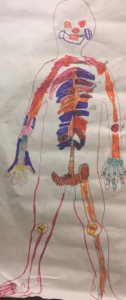Summer SAVY 2018: Session 1, Day 3 – Bioarchaeology (Rising 5th and 6th)
Did you know that being stressed can affect your bones? How about the ways in which our culture or environment can shape our skeletal development? These were our main topics today as we looked at bone development and the factors that influence them.
We started out by discussing the biocultural model. Comprised of three elements (cultural stressors, biological stressors, and environmental stressors), the biocultural model can help us understand how some populations are affected by things such as crowding, social inequality, disease, disability, drought, natural disasters, and many more factors. We further broke this category into components like environmental restraints, cultural buffering, culturally induced stress, host resistance factors, and physiological disruption, then applied the model to examples of world disasters (both real and fictional).
We then moved into discussing bone development of the appendicular skeleton. Long bones, such as the femur, tibia, fibula, radius, and ulna can provide us with a plethora of information. We can establish age, stature, and activity patterns, injury to better understand an individual or population. As human grow from infancy through their early 20’s, their bones are still developing. If we look at these long bones in younger people, we can see where their bones have not fully fused together, but instead are held together by cartilage. We can estimate an age based on the fusion, or lack thereof, of these epiphyses. We can also determine stature based on the long bones. Using an osteometric board, we practiced measuring femurs and plugging the number into a formula that will give us the height of the whole skeleton.
In the afternoon, the students broke into groups and were given a pathology to research and find out how it affects the bone. They became experts on diseases such Rickets, Scurvy, Linear Enamel Hypoplasia, Cribra Orbitalia, Schmorl’s Nodes, and many more. They presented their findings to their classmates and further displayed how stress to the body impacts the skeleton.
After learning this, we talked about bone structure and formation in both flat and long bones, learning about elements such as spongy bone, compact bone, blood vessels, and bone marrow. Using this information the students built their own bone models out of classroom materials – look for these during open house on Friday!
Dinner Discussion Questions:
- Ask your student to explain the role of osteoblasts and osteoclasts during the process of ossification (https://en.wikipedia.org/wiki/Ossification)
- Ask your student to give an example of the ways cultural, environmental, or biological stressors might impact health and development, and the ways our families and communities work to protect us from these stressors.

